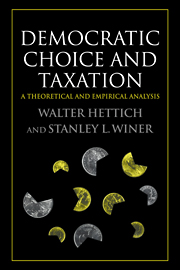Book contents
- Frontmatter
- Contents
- Preface
- 1 Introduction
- PART ONE THEORETICAL FRAMEWORK
- PART TWO COLLECTIVE CHOICE AND THE NORMATIVE ANALYSIS OF TAXATION
- PART THREE APPLIED GENERAL EQUILIBRIUM ANALYSIS
- 7 Tax Policy in a Computable Model of Economic and Political Equilibrium
- PART FOUR STATISTICAL ANALYSIS OF TAX STRUCTURE
- PART FIVE POLITICAL INSTITUTIONS AND TAXATION
- Bibliography
- Name Index
- Subject Index
7 - Tax Policy in a Computable Model of Economic and Political Equilibrium
Published online by Cambridge University Press: 08 October 2009
- Frontmatter
- Contents
- Preface
- 1 Introduction
- PART ONE THEORETICAL FRAMEWORK
- PART TWO COLLECTIVE CHOICE AND THE NORMATIVE ANALYSIS OF TAXATION
- PART THREE APPLIED GENERAL EQUILIBRIUM ANALYSIS
- 7 Tax Policy in a Computable Model of Economic and Political Equilibrium
- PART FOUR STATISTICAL ANALYSIS OF TAX STRUCTURE
- PART FIVE POLITICAL INSTITUTIONS AND TAXATION
- Bibliography
- Name Index
- Subject Index
Summary
As, in spite of the great differences in form between birds and quadrupeds, there is one Fundamental Idea running through all their frames, so the general theory of the equilibrium of demand and supply is a Fundamental Idea running through the frames of all the various parts of the central problem of Distribution and Exchange.
Alfred Marshall (1890, p. vii)We think the attempt to operationalize a large body of existing theory, developed through the 1950s and 1960s and devoted largely to nonconstructive proofs of the existence of equilibrium, is beneficial in the long run. We also believe that the insights generated on policy issues by using techniques of this kind, if quantified in the appropriate way, can help to raise the level of policy debate. The use of any model of social process is not without problems, but done in an intelligent and focused way and in the context of contemporary debates on policy issues, the rewards can be large.
John Shoven and John Whalley (1992b, p. 280)We showed in Chapter 4 that, in a world described by the probabilistic voting model, decision makers choose policies that are economically as well as politically efficient. These policies reflect three essential elements: the demands of voters, differences in their political responses and influence, and the operation and constraints of the private economy.
- Type
- Chapter
- Information
- Democratic Choice and TaxationA Theoretical and Empirical Analysis, pp. 153 - 192Publisher: Cambridge University PressPrint publication year: 1999



